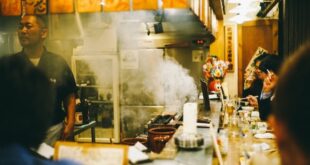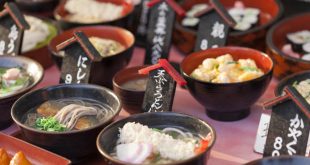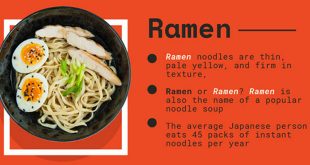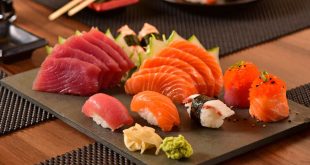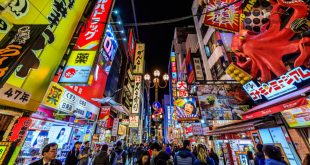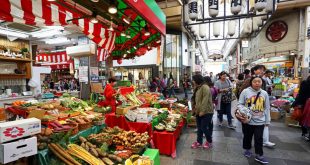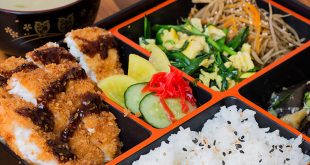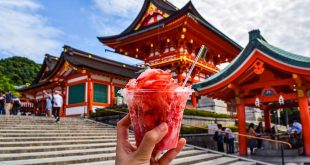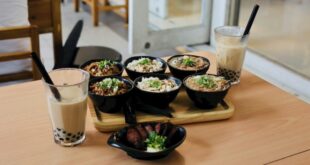Last Updated on March 15, 2023
Japan boasts many unique and fascinating attractions, from the sublime slopes of Mount Fuji to sumo wrestling matches in Osaka. But today, more and more, it’s Japan’s unique cuisine what draws visitors to the Land of the Rising Sun. Each major tourist city within Japan offers its own local dishes. Regional food reflects the history and geography of the area. Check out this foodie guide to Japan and learn what to eat in the main three cities to enjoy the best traditional Japanese food.
1. Tokyo
Because Tokyo has served as Japan’s capital city for four centuries, its local specialties have spread out across the nation and become standard Japanese fare. Tokyo means “Eastern Capital”. Before it became the capital, the city was known as Edo. For this reason, local specialties are called Edomae, which literally means “in front of Edo”. You may have heard of the following three dishes you should try while in Tokyo.
Tempura
View this post on Instagram
Tempura is vegetables or seafood battered and deep-fried. The best way to enjoy tempura in Tokyo is to visit a tempura-ya, which is a small restaurant specializing in tempura.
Tempura was originally inspired by Portuguese sailors who introduced this cooking technique in the 16th century. Originally, only vegetables were fried. In fact, the name of the dish comes from a Latin calendar date “quatuor anni tempora”, which is a period of fasting when no meat is allowed. Over the centuries, the Tokyoites adapted the technique for fish.
Soba
View this post on Instagram
Soba are thin noodles made from buckwheat flour that offer an alternative to the thick wheat-flour noodles called udon. This dish can be served in a hot broth or chilled with a dipping sauce. As you may have guessed, a soba-ya is a small restaurant only serving soba.
In Tokyo, yellow, gray, or green-colored soba are most often served cold with a thick, strong dipping dish. When eating soba in Tokyo, don’t apply too much dip to your noodles.
Nigiri-zushi
TAKEAWAY: Did you know that Nigiri-zushi means “hand-pressed sushi”? It is a popular kind of sushi that originated as fast-food in Tokyo. A small ball of rice covered with a tuna or salmon topping and served with wasabi.
The Tsukiji Outer Market is a great place to eat fresh nigiri-zushi, but you’ll find it served in all sushi restaurants around the capital. A single order of nigiri-zushi is two pieces, but you’ll only get one piece in a sampler set of different kinds of sushi. And if you are a sushi lover, check out this visual guide to eating sushi in Japan.
2. Kyoto
Kyoto is in many ways the cultural heart of Japan. For over a thousand years, it was Japan’s capital city.
Buddhist temples in Kyoto often served meals to visitors, effectively operating as restaurants. The food they served was vegetarian as was appropriate for devout Buddhists and was known as shojin ryori, which means “devotion cuisine”. Many of the traditional dishes served in Kyoto are influenced by shojin ryori.
Yudofu
Yudofu is simply boiled soft tofu and kelp served with a dipping sauce. It is considered to be Kyoto’s signature dish. You’ll find several specialty yudofu restaurants around the Nanzenji Temple.
Kaiseki-ryori
Kaiseki-ryori is more an art form than a meal. It is a set sequence of dishes presented to a guest in an artful manner, much like the famous Japanese tea ceremony. The dishes are typically small and aesthetically pleasing. Only local, seasonal ingredients are used. The color and pattern of the food in the dish is as important as its taste and texture.
If you stay in a ryokan (very traditional Japanese inn) in Kyoto, a kaiseki-ryori will be served as part of your experience. Alternatively, you can experience a kaiseki-ryori in a high-end restaurant.
Tsukemono
Tsukemono are pickled vegetables. When Kyoto was the capital of Japan, people brough fruits and vegetables from all over Japan to serve to the nobility. Tsukemono pickling was developed as a means of preserving these fruits and vegetables in an age before food dehydrators were invented. While fruits and vegetables, along with fish and meat, may taste better when preserved in a food dehydrator, this pickling technique is now a tradition, so be brave and try some!
You’ll find three popular varieties of tsukemono in Kyoto. These are sugizuke (turnip), senmaizuke (turnip and kelp), and shibazuke (cucumber and eggplant).
3. Osaka
Osakans have a reputation for eating. A lot! There is a saying in Japan: “People from Kyoto are bankrupted by buying too many clothes; people from Osaka are bankrupted by overspending on food”.
You can expect to find many of the best restaurants in the world in Osaka. Osakans always demand high-quality cuisine.
Teppanyaki
Teppanyaki is food griddled at the table. Some people enjoy eating in teppanyaki restaurants just to watch the chef juggling the food. It’s a similar experience to watching a mixologist at work in a busy cocktail bar. The main ingredient of traditional teppanyaki food is high-quality seafood or beef.
Kitsune udon
While Tokyo has its soba, Osaka prefers kitsune udon. This is thick wheat-flour noodles with deep-fried tofu served in a hot broth. If you think the word kitsune is familiar, you probably watch fantasy TV shows. Kitsune is the Japanese word for fox and is applied to the fox spirits that appear in many stories. This noodle dish is called kitsune udon because it is said that foxes love it.
Takoyaki
Takoyaki is octopus coated in an egg and wheat-flour-based batter and grilled with green onion and pickled ginger. A special takoyaki pan is utilized for the process. You’ll see takoyaki around the streets of Osaka served as a popular snack.
Enjoy your visit to Japan!
You’ll find a wide variety of regional dishes around Japan. Other great food cities include Fukuoka, Hiroshima, Kagoshima, Nagoya, and Hokkaido. The island of Okinawa features a unique and interesting cuisine due to its separation from the mainland of Japan. And to start preparing your first trip to Japan, you may want to follow these six Japanese food bloggers. Anyone who loves food will love Japan!
 Travel for Food Hub The Food Blog for Travel Lovers
Travel for Food Hub The Food Blog for Travel Lovers


